YOUR CART
- No products in the cart.
Subtotal:
$0.00

‘Architecture arouses sentiments in man. The architect’s task, therefore, is to make those sentiments more precise.’ Adolf Loos
Like architecture, textile art can stimulate emotion, both in the artist and in the viewer. So what happens when architecture and textile art are combined?
We looked at the work of five artists and one couple, who include buildings of all kinds in their art using a variety of materials and techniques. From appliqué and collage using Indian sari silks and trimmings to aerial maps layered with silk organza. They design structures using fine, illustrative hand and machine stitch, some in knitted cotton yarn, others shaped out of shimmering rayon thread on the finest Irish linen. Each has a beauty, style and impression of its own.
Jackie Gale, Valerie Goodwin, Deborah Toner, Jake Henzler, Gillian Bates and Charles-Henry and Elin Petronella share with us their ideas, their hows and whys – and a piece that was fit for a queen.
You may never look at buildings quite the same again.
When you behold the beach and seaside scenes in Jackie Gale’s artwork, you almost sense her joy at picking the vibrant fabrics that make up her illustrative and appliquéd textile art. Pops of sky and sea blues, contrasted with green grasses and the pinks, yellows and oranges of flowers and buildings showcase the cheerful scenes of the Devon and Cornwall coast where Jackie lives.
Her playful and simplistic style, filled with colour, light and texture, is not only restricted to flora and fauna but finds its way into the beach huts, shops and houses that she collages, such as in her imaginative piece Sea Town.
Sea Town is a vibrant collection of quirky houses in an imaginary seaside town, loosely inspired by the Cornish town of Fowey.
As with most of her pieces, Jackie began with a sketch on the backing fabric. She then chose vintage sari fabric remnants, sourced directly from India, for their vibrant colours. The texture of the silk and the details and trims on the saris were the perfect addition for intricate features.
Jackie Gale: ‘The longest time I spend on a piece is on the preparation. I drew and cut out each house individually. Ensuring a variety of shape and colour was essential as I really wanted to attract people to the finer details. I usually create way more than actually ends up in the artwork as I want to have plenty to choose from when it comes to the composition and layout.
‘The next step was to layer the background scene with the larger components of fabric (the sky and sea) securing them with free motion stitching on a machine. I pinned all the houses on and used the same technique to construct them, gradually building the scene with smaller pieces and eventually moving on to the embellishment. I usually drift off the original sketch – pieces tend to evolve as new ideas arrive throughout a piece of work such as this.
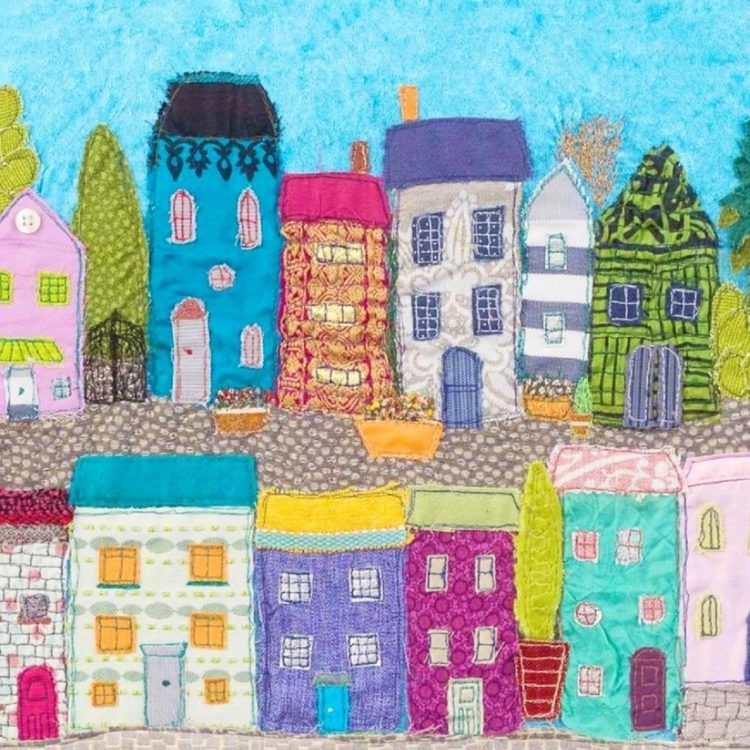
‘Over time, I’ve been developing my skills and exploring the endless possibilities that textile art allows. From this, my style has become looser, more creative and I allow the textures to tell the story.
‘I love using my imagination and creating Sea Town really fed my passion for creativity. I love intricate work, vibrant colours and architectural detail so this really ticked many boxes for me. I believe many artworks reflect an artist’s mood, mind state and character. I can recall the happiness of creating this piece for a joint summer exhibition in Plymouth – it was a joyful and exciting time. I’m sure that sentiment is embodied in Sea Town.’
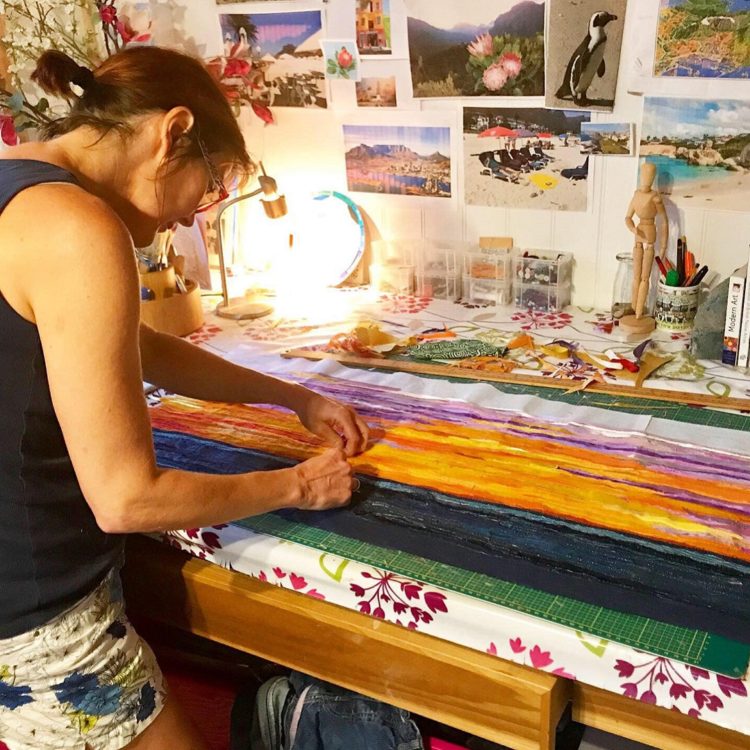
Jackie Gale is a contemporary textile artist who runs her own art gallery and studio, Edge West Studio at Yealmbridge in Devon. Jackie is self-taught and has worked professionally since 2012. In 2015 she was awarded Best Up and Coming Artist by the Fine Art Guild and, since then has exhibited at galleries across the UK. Her works are held in private collections in the UK and overseas.
Website: jackiegaletextileart.com
Facebook: facebook.com/jackiegaleartist
Instagram: @jackiegaleart
Valerie Goodwin of Tallahassee, Florida, USA has a quite different perspective on architecture – she views it from above. The inspiration for her quilts – her primary art form – comes from her love of aerial views of landscapes and cities. From this she designs her art quilts as maps, both real and imaginary, using machine piecing and applique.
Not only is Valerie an accomplished quilt artist and workshop leader, she adds an extra dimension to her work through her training and experience as an architect and lecturer.
‘When I first connected with quilting, I immediately knew that I wanted to use my architectural background to guide how I used this medium.’
But Valerie’s work is not simply about exquisite textile art. Her fibre art maps are sometimes used to tell the stories of issues and events, both past and present – as in African Burial Ground II.
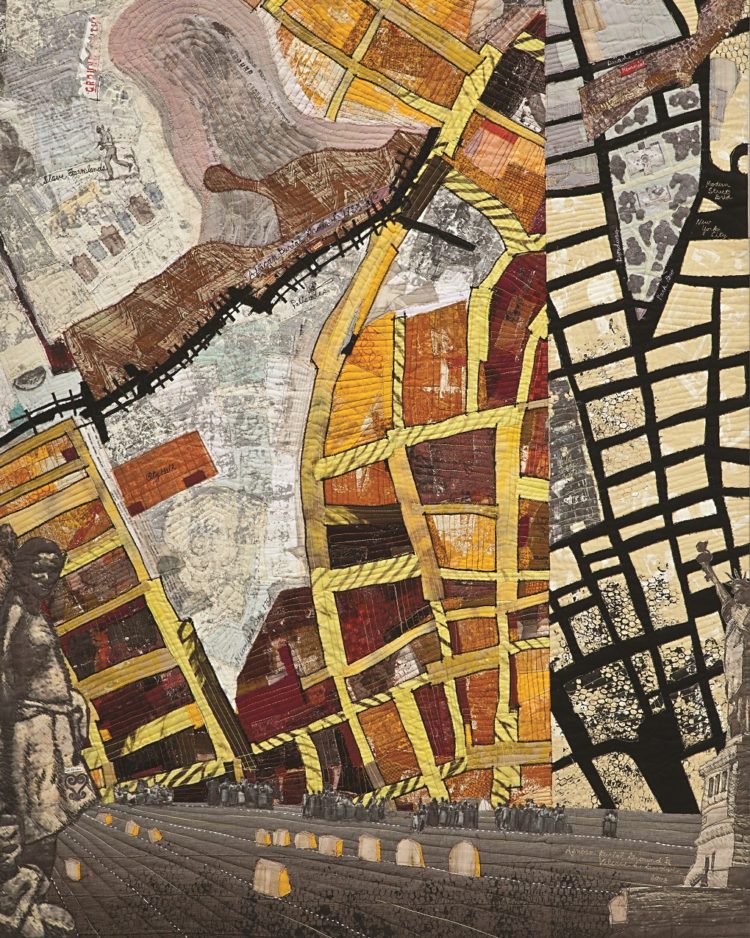
Maps intrigue Valerie, both as an art form and as a vehicle for artistic expression. She sees them as personal explorations of map language and imagined landscapes and most of her pieces are not consciously based on a specific place. However, the story of the African Burial Ground, a real place, inspired her piece African Burial Ground II.
During excavation for the Foley Square Federal Building in lower Manhattan in 1991, preliminary archaeological research uncovered a burial ground thirty feet below street level containing over 15,000 intact skeletal remains and graves of free and enslaved Africans and African Americans, who had lived and worked in the Dutch colony of New York. Public protest was heard from the Black community at the disturbance of the graveyard, construction was halted, and a redesign created to preserve the area of the burial ground.
Valerie Goodwin: ‘On the left side of the quilt is a map of the slave farmlands, the cemetery and Dutch settlement during 1755. It is said that the slaves were given these lands to give the colonists a buffer zone between them and the hostile Native Americans to the north. The right side of this quilt is a map of lower Manhattan as it exists today. The quilt is anchored on the bottom with an imaginary scene of the burial site.
‘The goal of this piece was to celebrate our remarkable journey in this country – especially in light of the relatively recent election of the USA’s first African American president, Barack Obama. For me, it was important that this subject matter inform my art in order to map the memories and experiences of our history as slaves.
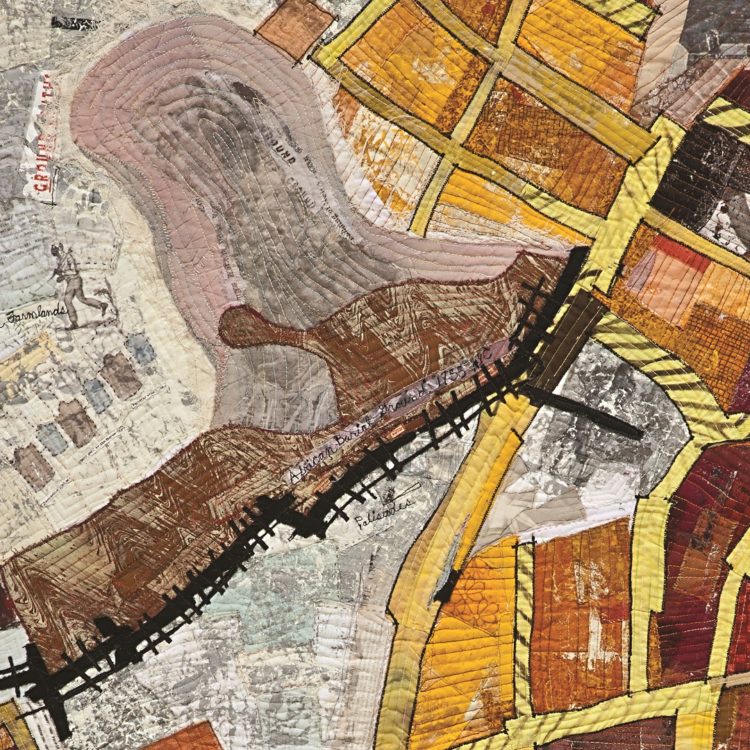
‘When making my quilts, the background layer is usually made up of large pieces of fabric stitched together using machine piecing or hand appliqué. I like layering and experimenting with the effects of transparency, which is why I choose to use silk organza. I enjoy hand stitching to keep the pieces in place and to add texture. My go-to stitches include couching, running stitch, and back stitch. This process provides the evidence of the human hand.
‘These days I use digital technology as a way of working with fabric and it’s unique to my work. I use a laser cutter to create patterns and designs by cutting into fabric: it’s distinctive in the intricacy and complexity of the lines and shapes this technology can create. This process allows me to create fibre art that is lace-like and intricate while incorporating a variety of less technical stitched-art techniques that aren’t part of the digital realm.
‘I took great pleasure in creating African Burial Ground II, exploring my technique of multi-layering fabric and composing both the current-day and historic maps and imagery using fabric, paint, and thread. But not least was that I was able to convey such an important story.’
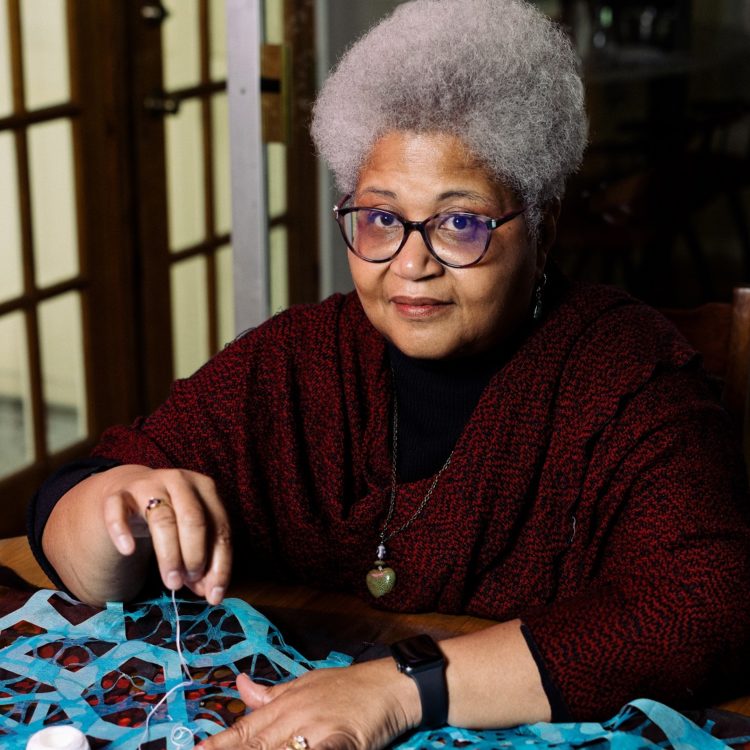
Valerie Goodwin is the author of Art Quilt Maps, Capture a Sense of Place with Fiber Collage –A Visual Guide, and for 26 years taught architectural design at Florida A&M University.
Her award-winning fibre art work has been widely published and exhibited in museums and private collections, and she lectures and gives workshops nationally and internationally.
Website: www.valeriegoodwinart.com/
Facebook: ValerieGoodwinArt
Instagram: @valeriegoodwinart
Luxurious Irish linen is famed for its softness, finesse, and natural lustre, combined with a strength that will make it last a lifetime. So what better base could there be for homeware items, intricately machine-stitched with architectural details, and performed by a Belfast-based, architect-trained textile artist?
Since 2011 Deborah has combined her love of architecture and interiors to produce a range of beautiful, embroidered gift and homeware textiles. Her ranges include the cities of Belfast, Dublin, Derry and Edinburgh and include images of buildings, maps and skylines stitched onto lampshades, cushions, footstools, picture mounts and zip pouches.
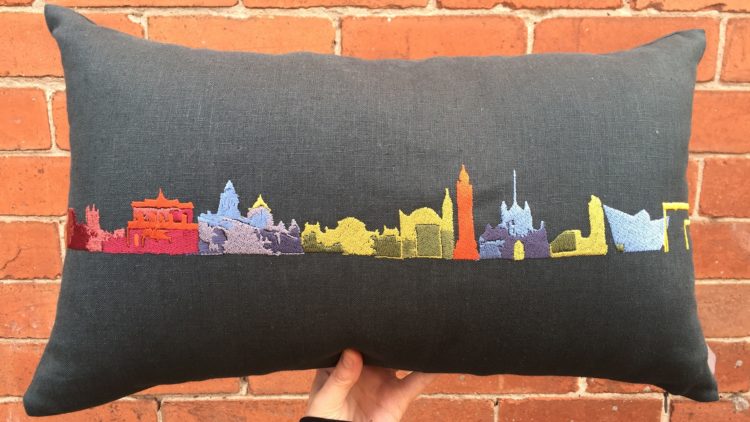
Deborah Toner: ‘I have worked on so many different commissions embroidering churches, ruins, city halls, or even maps of the area where people got married. I also get asked to embroider lots of different houses, from quaint terrace cottages to castles and country estates.
‘I use a Tajima multi-needle embroidery machine, which has 15 heads for embroidery. I also have a number of domestic machines for construction, which include my favourite, a Pfaff. I use Royal Rayon thread for its quality, shine and range of colours. I’ve never used anything else.
‘I believe it’s really important to buy good quality pieces that will last, so that’s what I make and it’s why I only use locally woven Irish linen.
‘I was asked to make some cushions as an official gift from Belfast city for Queen Elizabeth II when she visited in 2014 and I chose Multicoloured Belfast Skyline as the design. This led to a further contract to make work for Historic Royal Palaces at Hillsborough Castle.
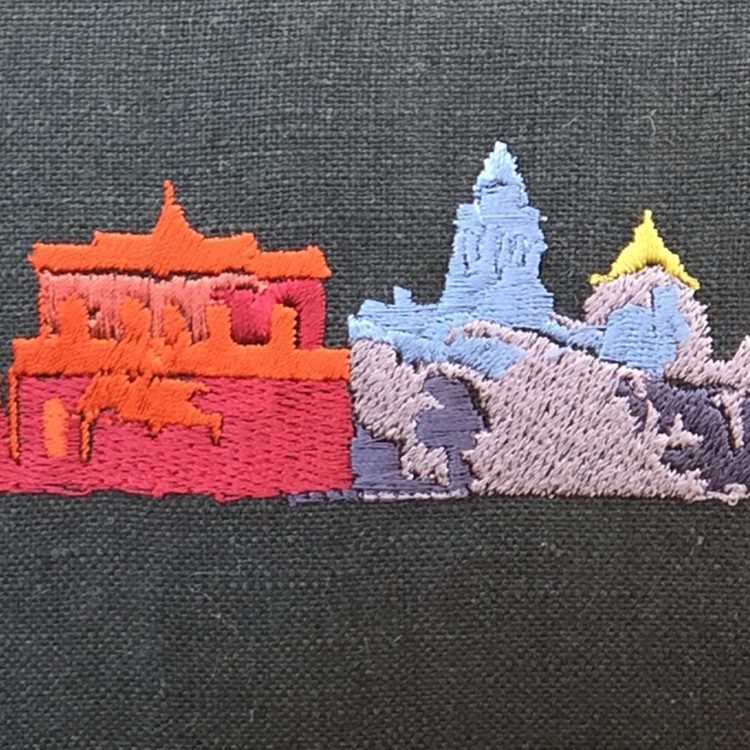
‘Multicoloured Belfast Skyline followed on from my first ever design, Outline Skyline, which was a simple outline without the coloured embroidery. I created a skyline by piecing together my drawings of iconic buildings in Belfast. Having studied a Masters in architecture, it seemed a natural step to develop that for my own city. I wanted a way to be a little freer with my work and to capture the idea of ‘painting with thread’. It was also an opportunity to experiment with lots of colour in quite a pared back way.
‘I used my initial hand drawn outline design and machine stitched over it. I tried to balance breaking up the colours with different elements of the buildings. I also played about with my stitch direction which allows the light to catch colour differently. I wanted to keep the embroidery heavy enough to be tactile but still light enough to still be able to pick up on some small building details so as to be recognisable. This involved lots of playing and testing.
‘This was the first piece where I really used block colour, which led to more works in the same way. I also love that each one will be different: I change the colours, the sequence and most require hand finishing so they really are individual. The only thing that remains the same is the iconic Harland and Wolff Cranes, which I always embroider in ‘cranes yellow’ thread.
‘I am working on some new Belfast designs and have been looking more closely at elements of the shipyard. It is such a rich part of our culture and heritage and I believe it’s what gives so many of the creatives based here their industrious charm.’
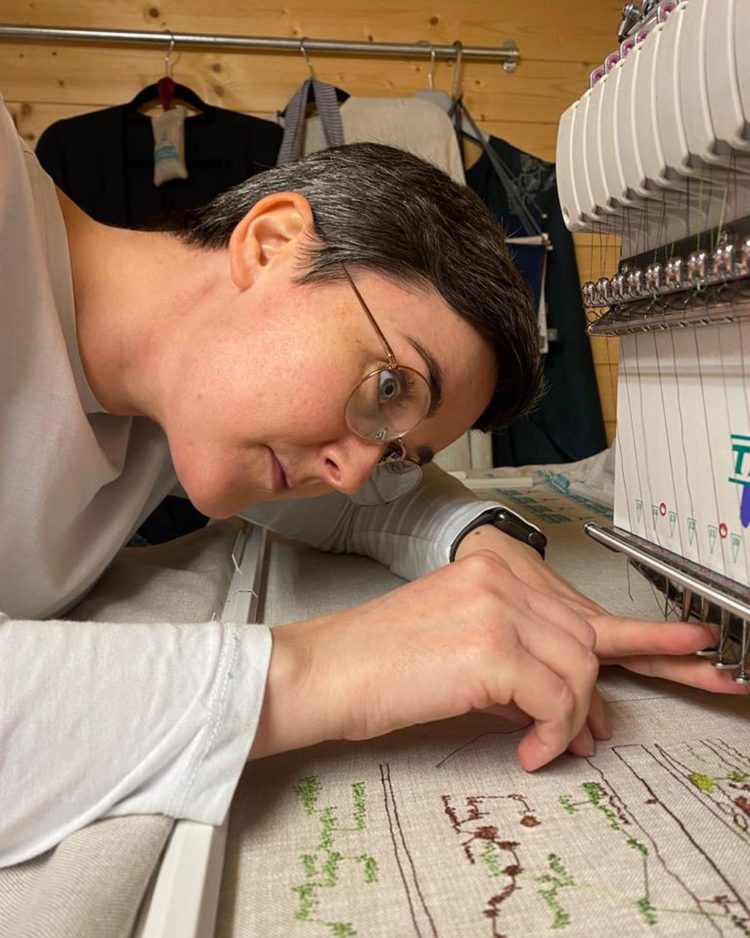
Deborah Toner Architectural Embroidery, offering a bespoke architectural embroidery service. She embroiders maps and cityscapes from all over the world, as well as individual houses and streetscapes for her growing customer base.
In 2021, ten years after helping her to launch her business, the Ulster Museum commissioned a second body of her work for their permanent collection.
Website: deborahtoner.co.uk
Instagram: @deborah_toner
‘Rome wasn’t built in a day’ is a phrase applied to tasks demanding both time and patience. And this was true for Sydney-based knit and crochet designer Jake Henzler as he developed his skills and grew his career. But for Jake, it wasn’t Rome but Copenhagen that he built – in cotton yarn. Once Jake had taught himself how to knit, purl and carry over many coloured wools, he designed a set of knitted building blocks for the city that he had fallen in love with.
Known on Instagram as @boy_knits_world, Jake works mainly with yarn and needlecraft techniques and is most well known for his knitted cityscape blankets. His work aims to reduce the simple beauty of buildings to their most basic expressive patterns in knitted colourwork.
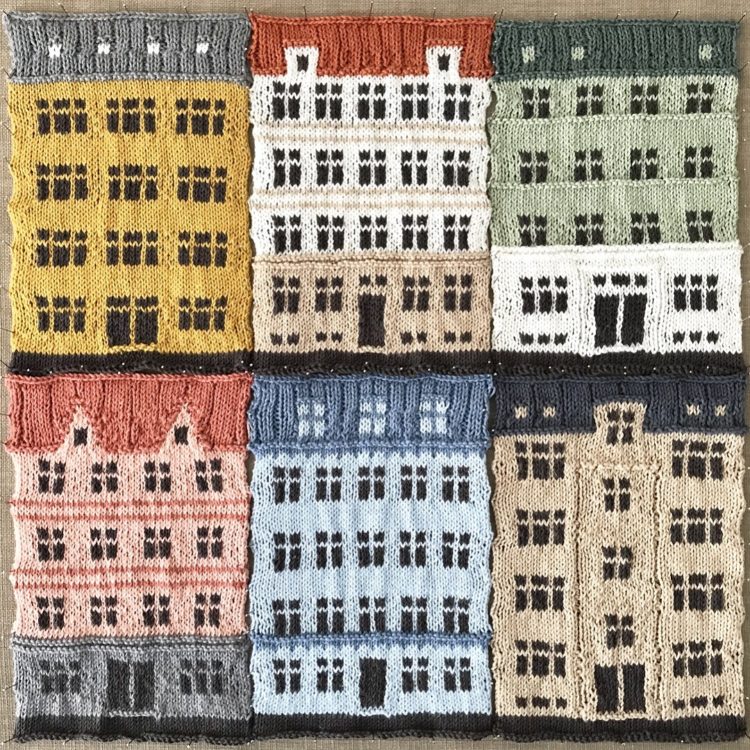
Jake Henzler: ‘It was 2017, I was living and working as a teacher in Copenhagen and I decided that I wanted to make a blanket that would commemorate my year there. I visited yarn stores around the city and was impressed by the incredible range of cotton colours at Søstrene Grene. It was there that I chose the cotton for Copenhagen Building Blocks. Their range included more sophisticated colours than the usual bright pastels – like a washed-out terracotta, olive greens and a dusty blue.
‘I also experimented a bit with dyeing, fading and staining, which allowed me to create tone variation in the colours I had and create more appropriate colours from the brighter shades.
‘The regularity of shape is one of the most striking things about the apartment buildings of Copenhagen. They were built in a relatively small space of time, with long, straight streets that form grids across the city, lined with buildings that look like modest mansions. They weren’t allowed to build more than six storeys high, ensuring maximum light could reach all streets and homes. It resulted in a regularity of height across the city. The buildings are also often painted in sensible adult pastels that blend really beautifully together in a row. All of these elements spoke to my own sense of design and felt like principles I wanted to transfer to my work.
‘I developed a series of core patterns to operate as adaptable templates that describe an entire city.
‘The principle of allowing people to reproduce and adapt elements of the pattern to describe their own experiences is central to the work’s purpose.
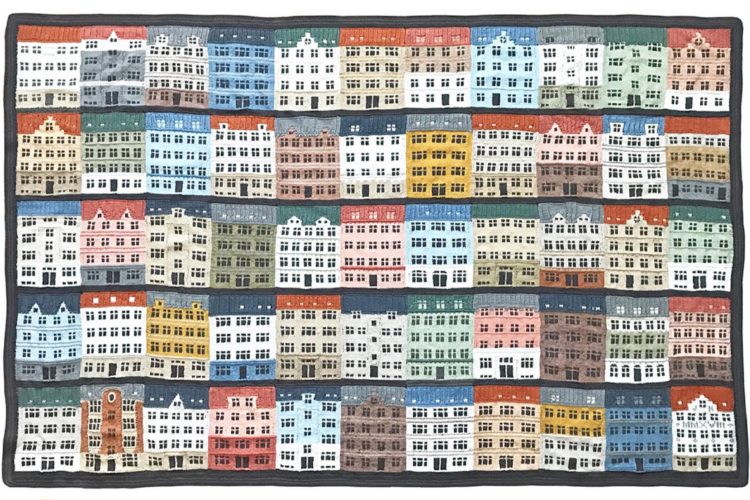
‘Setting some limitations, whether they’re necessary or artificial, often drives me to take interesting approaches or rethink the way I might have made something. The windows of the Copenhagen Building Blocks are a good example. When I set out designing the blocks, beginning with the tea shop with tea canisters in the window, it became clear that the detail was both an unnecessary complication and a distraction. It was hard to capture the level of detail without going very large scale.
‘Instead, I tried to reduce the windows to the simplest form I could without losing the distinctive tall shape. The silhouetted version in dark grey ended up being the most practical, and because it’s used across every block, it also has a unifying effect on the colourful movement of the many facades.
‘The next test knit was a plain building, which worked and seemed easy enough to adapt into other designs. I’d originally wanted to knit every building that had some significance to me, but in the end I did manage to make a few special buildings, including both of the apartment blocks I lived in.
‘The bigger projects take a lot of time, particularly when you’re testing new patterns to make sure the combination of all of the parts work together.
‘Through transposing my patterns onto the shape of a different garment they’ve been interpreted into a long coat and a pair of socks – it’s very impressive.’
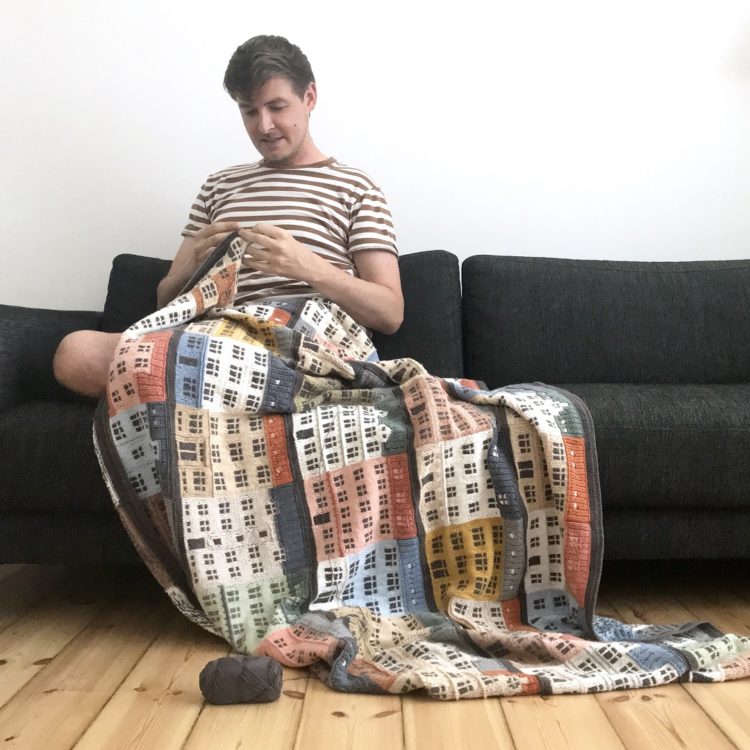
Jake is a designer who is self-taught at knit and crochet, and also incorporates patchwork. He lives in Sydney, Australia and works as a secondary school teacher. He has been practising and exhibiting his knitted and crocheted work internationally since 2006.
Instagram: @boy_knits_world
Ravelry: ravelry.com/patterns/sources/boy-knits-world/patterns
Textileartist.org’s full interview with Jake: textileartist.org/jake-henzler-boy-knits-world
Gillian Bates is based in Eastbourne, East Sussex, UK where she uses her sewing machine needle as a drawing stylus to create pictures showing memories of perfect moments in coastal towns. Gillian’s work is a pure celebration of the quirkiness of British life and she has derived inspiration from local areas such as Eastbourne, Brighton and Hastings, as well as more distant places including Margate, Bournemouth, Devon, Cornwall and London.
Gillian has stitched many seaside architecture-inspired embroideries, one of which is Beside the bandstand.
The bandstand is a subject Gillian has returned to many times as many couples choose to get married there, and she has stitched it as a wedding gift or memento.
Beside the bandstand is based on a structure at Brighton and Hove’s seafront. It had re-opened in 2009 after extensive refurbishment and was one of Gillian’s earliest pieces, made just a year after she became a full time textile artist.
‘I love the angle with which I have captured the bandstand, from the lower promenade looking up at the bandstand with the backdrop of Hove’s seafront.’
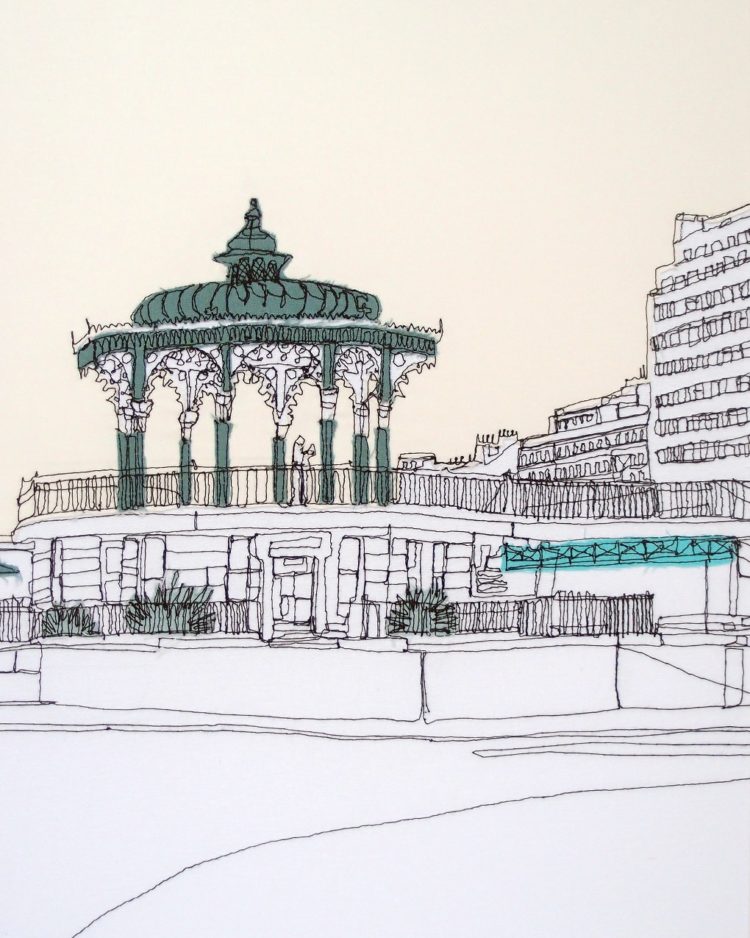
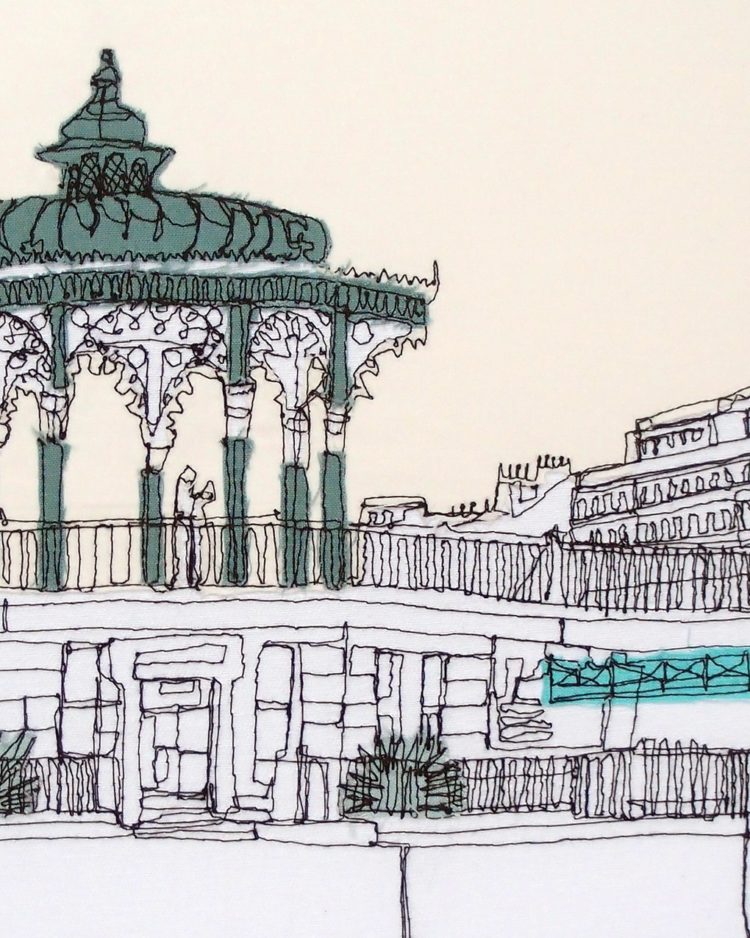
Gillian’s aim is to portray, not only the architecture, but also to capture the people and the general atmosphere. This adds another layer and gives it a sense of real time, though the bandstand was pictured on a quiet day. She selected a serene colour palette to give the feeling of being at the quieter end of the seafront, away from the hectic sights and sounds of the busier pier end.
Though the structure is stitched mainly with freehand machine embroidery, Gillian likes to include hand stitching where she feels a small stitch will indicate detail or where the machine won’t suffice.
Gillian Bates: ‘I meticulously plan out my pieces, starting with my preliminary pen sketches that I can transfer to my base fabric via a light box. Next, I choose the colour palette, selecting areas to add colour and gathering fabrics for these. I often use a pop of colour for the skies then select areas to highlight – in this case it was the bandstand itself, a sign and some bushes. That pop of colour provides a focal point for my composition and a sense of depth.’
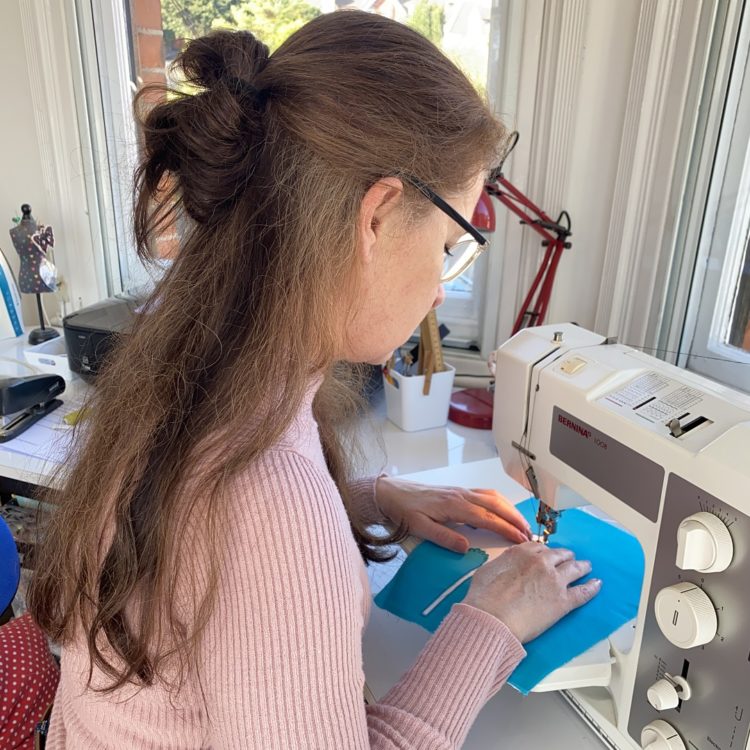
Gillian Bates has worked as a textile artist since 2008 and has also been a visiting lecturer for textile students. She lives and works in Eastbourne, East Sussex.
Her work has been exhibited both nationally and internationally, and she has produced for design studios and commercial clients including John Lewis and The View from the Shard.
Website: gillianbates-textiles.com
Facebook: facebook.com/gillianbatestextiles
Instagram: @gillian_bates
When Charles-Henry and Elin Petronella met and fell in love in Paris, and Elin introduced Charles to embroidery, the result was a shared passion for architectural embroidery. Today their online embroidery school Charles & Elin Academy offers an array of courses and each has many thousands of followers on social media.
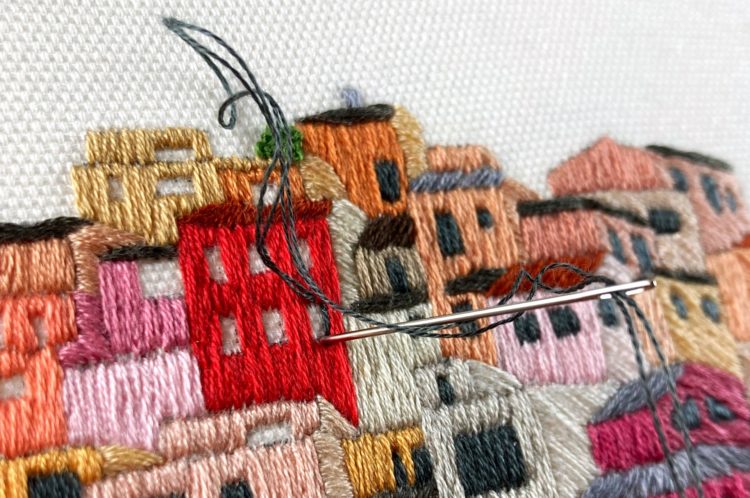
Their extensive travels, taking in and photographing stunning scenic views across Europe, have produced embroideries of buildings in many places. As their book title Mindful Embroidery – Stitch your way to relaxation with charming European street scenes suggests, their goal is also to encourage the joy of the art.
‘Embroidery is a process that grounds you and allows you to reconnect with yourself.’
Manarola is one of the most photographed towns of the Cinque Terre on the rugged Italian Riviera coastline. Vineyards and colourful houses, some dating back to the 1300s, cling to its steep terraces, fishing boats bob in the pretty harbour and trattorias delight in serving the most delicious seafood specialities.
So it’s no wonder that when Charles visited the idyllic town, it left a strong impression on him. After Charles and Elin moved to Montenegro in 2022 they established a studio, and with Italy being just across the Adriatic Sea they chose the Manarola vista as one of their first embroideries.
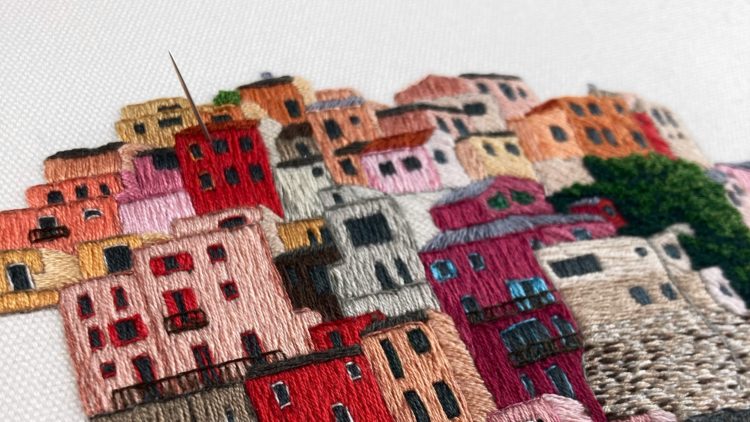
Though many of their embroideries are from their own photographs, to get the best impression they selected a resource image from a platform offering free images without any copyright infringement. Elin redrew the design free hand before transferring it to the cotton fabric and starting to stitch.
Elin Petronella: ‘Manarola took several months to complete and, when working on larger projects such as this, we often like to get in the mood by having a documentary about the place playing in the background. When you’re creating art inspired by places in the world, it helps you to immerse yourself in the location.
‘What I love about Manarola is the wide selection of colours and how they all harmoniously tie in together. The colours you work with can really have an impact on your mood and as I stitched this one it always brought me great joy.’
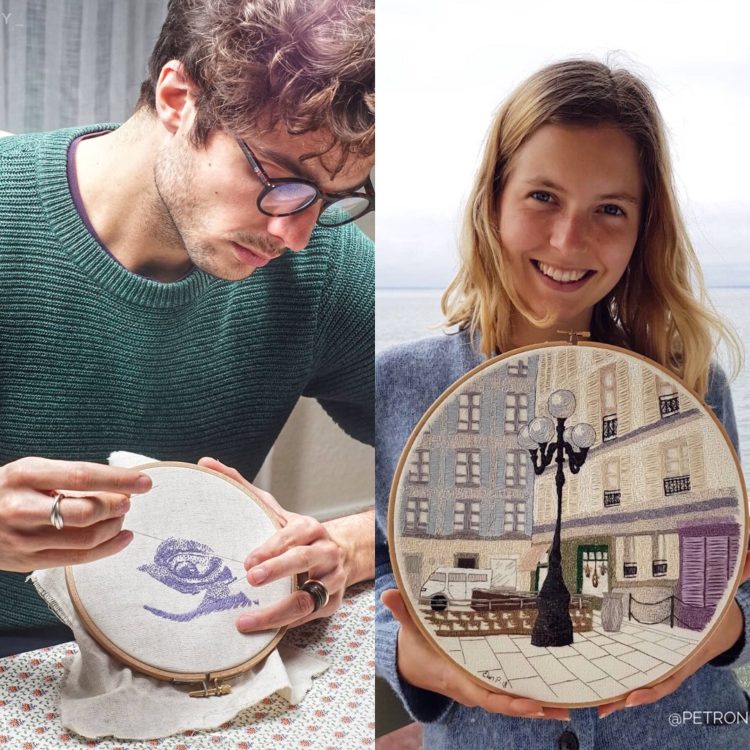
Charles and Elin Petronella have lived in Paris, Sweden and in 2022 moved to Montenegro. They have worked with brands such as Hermes in Paris and in 2020 published a book, ‘Mindful Embroidery’. The Charles and Elin Academy offers many embroidery courses and a membership programme.
Website: charlesandelin.com & charlesandelinacademy.com
Facebook: facebook.com/charlesandelin
Instagram: @petronella.art & @_charleshenry_
Textileartist.org’s full interview with Charles and Elin: textileartist.org/charles-henry-and-elin-petronella-a-marriage-made-in-thread
Inspiring architecture is all around us, from city centre buildings to cottages, manor houses and beach huts. Our artists have described very different ways of depicting architecture using thread and fabric. Why not try some of their ideas and techniques.
Textile artist Haf Weighton uses machine embroidery to stitch buildings of all kinds – check out our interview with Haf.
We’d love to know what you think about these artists’ work. Let us know in the comments below.